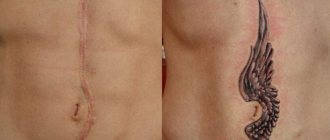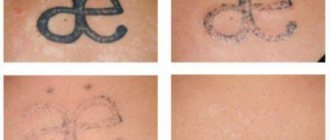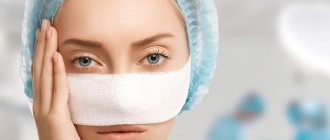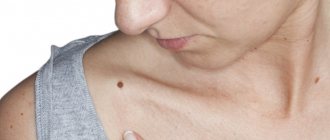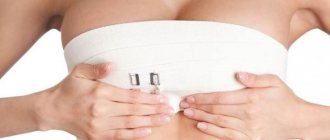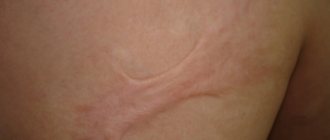Over the course of a lifetime, the human body undergoes dozens of different interventions. None of them go unnoticed, and many leave visible marks: for example, scars from childhood injuries and scars received after operations. These scars are not always decorative, and in some cases they can completely spoil the appearance.
There are methods that can be used to make scars less noticeable or completely invisible. If the problem of getting rid of scars is relevant for you, consider all the options - you will definitely find yours.
Of course, it is better to start fighting scars when they are relatively fresh. But a competent plastic surgeon can also be a salvation if the scars are old and traditional methods do not help get rid of them.
Table of contents
- Etiology and pathogenesis
- Clinical manifestations
- Principles of treatment
Surgical scars (scars, scars on the face, scars on the body, scars on the skin, scars ) are dense connective tissue formations on the skin that occur when normal wound healing is disrupted or in the presence of an extensive wound due to invasive intervention. According to statistics, more than 200 million large and small operations are registered every year in the world, after which more than 170 thousand new scars appear in patients in the United States alone.
In our company you can purchase the following equipment for removing surgical scars:
- M22 (Lumenis)
- Fraxel (Solta Medical)
- AcuPulse (Lumenis)
- Maximus (Pollogen by Lumenis)
Tattoos for stomach scars
The positive qualities of tattoos in this direction is the large area for the artist to perform the work. You can choose any design that will skillfully disguise your problem area on the stomach, and for this the artist can offer you a tattoo of any size. The only disadvantages of performing such sketches are increased pain and sprains that may appear in this area of the body.
Etiology and pathogenesis of scars after surgery
Surgical scars can occur as a result of any invasive procedure, be it a minor aesthetic procedure or a major operation. For example, they become a complication of many cosmetic procedures - deep chemical peels, dermabrasion, mesotherapy injections, contouring, electrocoagulation, etc. At the same time, scars never come on their own - they remain for life, often creating a noticeable cosmetic and / or functional defect of the organ and fabrics.
Scars after plastic surgery deserve special mention. On the one hand, they play the role of a structure that supports and fixes the tissues moved by the surgeon. On the other hand, rough and unaesthetic scars can completely neutralize the results of a brilliantly performed operation, cause psychological discomfort in a person, loss of self-confidence and cause social maladjustment.
The following factors influence the development of scar tissue:
- race;
- skin color (phototype);
- genetic predisposition (tendency to scarring);
- state of the endocrine system;
- state of the immune system;
- prolonged wound healing;
- severe inflammatory reaction in the wound;
- insolation in the early stages after wound healing;
- the use of certain medications and physical factors after wound healing;
- foreign bodies in the wound (suture material, permanent fillers).
The morphological signs of scars are :
- fibrous-changed dermis;
- inferiority of the epidermis;
- absence or reduction in the number of skin appendages (for example, hair follicles) with a pronounced impairment of their function.
It is noted that even after the completion of the acute phase (tissue repair in the case of surgical interventions or subsidence of inflammatory reactions after the introduction of fillers), the pathological processes in the scar do not end, but proceed according to their own, not yet fully understood laws.
Fibroblasts, keratinocytes, blood vessel cells, macrophages, plasma cells, lymphocytes, melanocytes, Langerhans cells, hormones (thyroid and ovarian, etc.) and cytokines (TGF-β, VEGF) contribute to the development of scars. The combination of these factors may be different in each case.
Who is at risk?
Most often, true colloid scars occur in middle-aged people. False ones, in turn, can occur at any age as a result of past and chronic skin diseases, after severe burns, as well as in women during pregnancy due to very strong and uneven stretching of the rather delicate skin of the abdomen.
Clinical manifestations of traumatic scars
Currently, more than 20 different classifications are known, most of which provide for the following types of scars:
- Keloid
- Hypertrophic
- Normotrophic
- Hypotrophic
- Atrophic
In 1990, the Vancouver Scar Scale (VSS) was first introduced, which today has several modifications. According to one of them, scars are assessed by a number of points from 0 to 11 ( Table 1 ).
Table 1. Vancouver Scar Rating Scale
|
|
| normotrophic - 0 points; · hypertrophic homogeneous - 1 point; · hypertrophic with nodules – 2 points; · noticeable keloid – 3 points; · pronounced keloid – 4 points. | normal - 0 points; · slight compaction – 1 point; · pronounced induration – 2 points. |
|
|
| · healthy skin – 0 points; · slight erythema - 1 point; · severe erythema - 2 points. | · tension - 0 points; · itching – 1 point; burning sensation - 2 points; · pain - 3 points. |
Some features of postoperative scars and methods of their treatment:
- Normally, the scar at the site of a surgical wound that has healed without complications becomes smooth, thread-like, almost uniform in color and density with the surrounding tissues within 6 months (primary healing).
- A sign of a complicated course of the wound process is a dense, uneven, “star-shaped” scar, often made of whitish or purple tissue (secondary healing).
- A dense, purple scar protruding above the surrounding skin may form.
- If the patient is prone to excessive formation of connective tissue, a keloid often forms ( Fig. 1 ).
- Evidence of cavities drainage is the presence of several small scars in addition to the main one. Their number indirectly indicates the volume of intervention, and their condition indicates the severity of the postoperative period.
Rice . 1. Keloid scars on the patient’s skin (Danish national service on dermato-venereology)
https://www.danderm-pdv.is.kkh.dk/atlas/7-54.html
Why does a scar form?
Keloids are divided into two groups according to their formation:
Primary (spontaneous)
These scars appear on apparently healthy skin for no apparent reason.
The appearance of such keloids can result from:
- Hormonal imbalances;
- Internal injuries;
- Pregnancy;
- Chronic diseases.
Typically, scarring occurs on the neck, back, chin and jaw line, ears, especially the earlobes.
Secondary (false)
Such scars occur in areas of previously damaged skin due to any injuries, skin lesions and ulcers. Wound healing is often inhibited by infection, causing inflammation and scarring.
The reasons include the following:
- Unprofessional surgical intervention;
- Injuries, cuts and wounds healed without proper care and supervision of a specialist;
- Consequences of severe skin diseases, such as acne.
Principles of treatment and removal of scars after surgery
Prevention of scar growth
To prevent scar formation, silicone preparations are used topically, both in isolation and as part of complex therapy. For example, silicone dressings are used to prevent and treat scars on areas of the body covered by clothing.
Antihistamines normalize the level of interleukins 4, -12, -13 and prostaglandins, and also reduce the level of histamine, which promotes better wound healing and reduces the likelihood of rough scars.
Period of intensive scar growth
Glucocorticosteroids inhibit the release of interleukins from lymphocytes and macrophages, reduce the production of vascular growth factor and tumor growth factor, block the division of myofibroblasts and reduce the number of mast cells. They can be used for excess scars, when their volume significantly exceeds the original volume of the skin.
Hyaluronidases (lidase, nidase, ronidase, longidase) destroy glycosaminoglycans and loosen the extracellular matrix. Their effectiveness depends on the correct choice of drug, dose, regimen and route of administration. The most effective is the injection of hyaluronidases directly into the scar tissue.
Collagenases (colalysin, fermencol, claridase) destroy the protein component of the extracellular matrix. These drugs are administered by injection (colalisin) or transdermally in various ways - electrophoresis, phonophoresis, using enhancers, etc.
One of the most effective methods of treating scars is compression therapy - it is recommended for a significant part of patients after surgery.
Cryodestruction is successfully used to treat hypertrophic and keloid scars. Healing after scar destruction by this method, as a rule, does not lead to its relapse.
Period of long-term consequences
During this period, you can use the possibilities of laser and mechanical (dermabrasion) skin resurfacing. Among the advantages of dermabrasion, it is worth noting the formation of a wound like an abrasion (minimizes the risk of re-scarring), a low risk of complications and the possibility of additional use of wound coverings.
In the presence of atrophic scars, the following methods of skin thickening can be used:
- Injections of collagen preparations.
- Introduction of hyaluronic acid in combination with proteins.
- Fibroblasts (autologous, allogeneic, embryonic).
- Stem cells
- Autologous fat grafting (lipofilling)
- Controlled skin damage (peeling, microneedling)
Surgical treatment is usually used when the risk of pathological scarring is low to create a smaller defect. The surgical method can move the scar from an open area of the body to a less noticeable area. Surgery is also indicated to restore the functional activity of the organ affected by the scar and to remove a foreign body from the scar after surgery.
Hardware procedures for the treatment of surgical scars, or rather the correction of scar deformities, mainly include laser exposure. In this case, there are 2 approaches to therapy:
- Firstly, you can influence a young, developing scar, setting the task of forming a defect that is as narrow and invisible on the skin as possible. In this case, vascular lasers and IPL are used, which selectively affect the vascular component of the scar.
- Secondly, an already formed scar (atrophic or normotrophic) can be successfully treated with fractional lasers - ablative and non-ablative. At the same time, by remodeling the dermis and scar tissue, it is possible to achieve an almost uniform area of skin without visible signs of a scar.
To a certain extent, changes in skin texture in the presence of a scar can be influenced using an RF device . In this case, they achieve skin tightening, straightening, tension and, as a result, improving the appearance of the scar.
The appearance of a keloid
There are three stages before the complete formation of a keloid:
- During the first 7-10 days, a thin epithelial layer appears on the affected area of the skin, which may be accompanied by painful sensations;
- Next, scarring occurs within 25-30 days, scar tissue protrudes above the main skin;
- After the formation of a scar in the affected area, the percentage of connective tissue increases, blood vessels disappear over time, and the scar becomes denser.
Still have questions?
If you have any questions or sign up for a free consultation with a surgeon, please call:
+7 (495) 255−50−11.
| Consultation with a dermato-oncologist surgeon | FOR FREE |
| Excision of scars (per 1 cm incision): | |
| Excision of scars on the body, 1 cm of scar | 3,000 rub. |
| Excision of scars on the face and neck, 1 cm of scar | 5,000 rub. |
| Correction of body scar with local tissues, 1 cm of scar | 5,000 rub. |
| Correction of face and neck scars with local tissues, 1 cm of scar | 10,000 rub. |
| Correction of retracted scars with Collost filler 7% - 1.5 ml | 13,000 rub. |
| Correction of retracted scars with Collost filler 15% - 1.5 ml | 18,000 rub. |
| Spherogel Lights 0.5 ml | 6,000 rub. |
| Spherogel Lights 1.0 ml | 11,000 rub. |
| Spherogel Medium 0.5 ml | 8,000 rub. |
| Spherogel Medium 1.0 ml | 15,000 rub. |
| Scar hormone therapy (Diprospan) | 1,300 rub. |
| Laser resurfacing CO2 1 cm2 | 2,000 rub. |
| Biopolymer removal | 40,000 rub. |
Prevention
By following simple rules, you will not only protect yourself from the growth of operated or treated scars, but also prevent the appearance of new keloids on the body.
To protect against colloidal scars you must:
- Do not allow tissue tension around the keloid;
- Do not take risks by trying to cure a scar on your own;
- It is forbidden to massage or put pressure on the damaged area;
- Do not expose the colloid to direct sunlight and avoid high temperatures;
- Let treatment take its course, ignoring and neglecting the advice of a specialist.
With proper care and timely treatment, this problem will not cause you much trouble and worry.
Myth 4: Scar treatments are dangerous to your health.
Before you start using any product to treat scars, you should consult a specialist and study the instructions.
If treatment is started in a timely manner and all doctor’s recommendations are followed, scar treatment products will not harm your health. Drugs for conservative treatment are not as expensive, less dangerous to health, and do not require an additional rehabilitation period than surgical methods.
If the instructions indicate that the components of the drug are not absorbed into the blood, but act only locally, then they are probably safe for most categories of people. Particular caution should be taken when using medications containing glucocorticoid hormones, as they have a serious number of contraindications and side effects. Collagenase-based products mostly act locally and do not enter the bloodstream. For example, the components of Fermenkol gel act directly on scar tissue and have no effect on metabolism, functions of cells, organs or body systems.
In any case, before using anti-scarring agents, you must consult your doctor!
General contraindications for the use of ointments, creams and gels for scars:
- Do not apply the product to scars located on the mucous membranes and eyelids.
- Sensitivity to individual components of the cream that resolves scars is a contraindication for use.
- Do not use if there are active inflammatory, purulent or necrotic processes.
- It is unacceptable to mix several types of medications when applied simultaneously.
- Should not be used if there is allergic inflammation in the area of injury.
- Oncological formations at the site of application are a contraindication.
Allergic reactions include: itching, rashes, blisters, pimples, urticaria, burning, dermatitis.
If one or another allergic reaction of the body occurs after starting to use the drug, then use of the product should be stopped immediately and consult a doctor !
However, it is necessary to distinguish between an allergic reaction and the natural healing process of the scar. In some cases, at the beginning of scar correction, the opposite effect is observed - swelling, hyperemia, the scar enlarges, which creates a false impression of its growth. Such effects are explained by the fact that when active substances act on the scar, it loosens and collagen bundles decrease, which leads to a decrease in pressure on the vessels and, as a result, an increase in the lumen of blood vessels. This condition of the scar does not require cancellation of the correction, but indicates the active destruction of pathological collagen in the tissues.
How to remove keloid scars using cosmetic procedures
At the ANACOSMA clinic, specialists have a non-surgical method for removing keloid scars. This is a combination of therapeutic treatment and cosmetic procedures.
First, the scar is transferred to a normotrophic state using injections of the drug Diprospan and a course of ozone therapy. After 3-6 months, if the condition of the scar is stable, laser resurfacing of the remainder is performed. This is the fastest, safest and most predictable way to deal with scars. The laser removes the upper layers of scar tissue and starts the skin regeneration process. As a result, the scar disappears, and young, normal skin appears in its place. To remove a scar, 1-3 procedures are required. An anesthetic cream is used for pain relief. The duration of the procedure is about 10 minutes.
After the procedure, redness and swelling persist for some time, and a crust forms at the site of the scar. This all goes away within a week. It is important not to remove or injure this crust yourself. If this happens, the procedure will be ineffective and the scar will remain.
After the procedure, it is important to avoid sunlight on the scar area - pigmentation may form. That is why laser resurfacing is recommended to be carried out in the autumn-winter period.
It is important to remember that without preliminary preparation, laser resurfacing of a keloid scar is absolutely impossible, as this can provoke uncontrolled growth of the scar.
General contraindications to laser resurfacing:
- oncological diseases;
- pregnancy and lactation;
- taking antibiotics, hormonal and diuretic drugs, NSAIDs;
- sunbathing a month before the procedure;
- acute infectious diseases one month before the procedure;
- operations within a month before the procedure;
- skin damage at the procedure sites.
In its formation, the scar goes through 4 successive stages:
1. stage of inflammation and epithelization.
It takes from 7 to 10 days from the moment the injury occurs. Characterized by a gradual decrease in swelling and inflammation of the skin. Granulation tissue is formed, bringing the edges of the wound closer together; there is no scar yet. If infection or divergence of the wound surface does not occur, the wound heals by primary intention with the formation of a barely noticeable thin scar.
2. stage of formation of a “young” scar.
It lasts from the 10th to the 30th day from the moment of injury. It is characterized by the formation of collagen-elastin fibers in granulation tissue. The scar is immature, loose, easily extensible, bright pink in color (due to increased blood supply to the wound).
3. stage of formation of a “mature” scar.
Lasts from the 30th to the 90th day from the date of injury. Elastin and collagen fibers grow into bundles and line up in a certain direction. The blood supply to the scar decreases, causing it to thicken and turn pale.
4. stage of final scar transformation.
Starting from 4 months after injury and up to a year, the final maturation of the scar occurs: the death of blood vessels, tension of collagen fibers. The scar thickens and turns pale. It is during this period that the doctor understands the condition of the scar and further tactics for its correction.
It is not possible to get rid of scars once and for all. With the help of modern techniques, you can only make a rough, wide scar cosmetically more acceptable. The choice of technique and the effectiveness of treatment will depend on the stage of formation of the scar defect and the type of scar. The rule applies: the sooner you seek medical help, the better the result will be.
